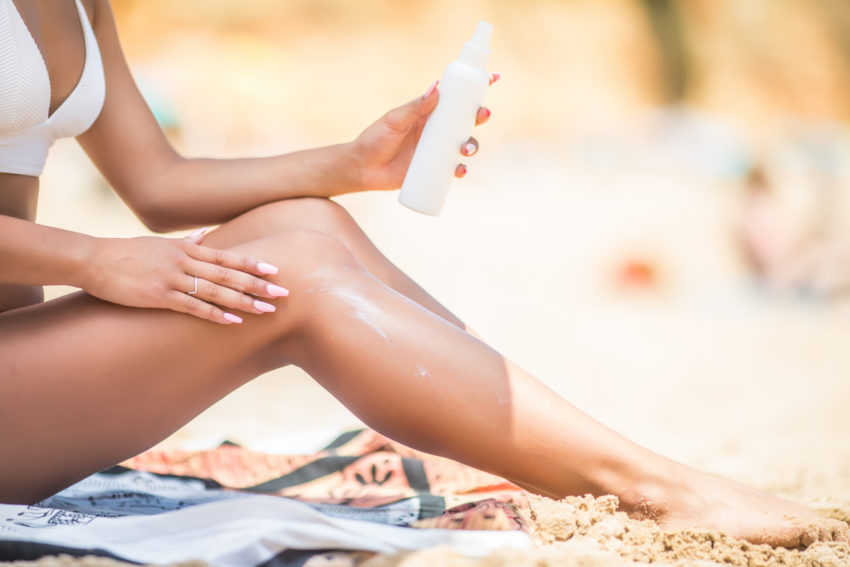
Share On Social!
Warning: This may send you running for sunscreen.
The rate of melanoma—the most dangerous form of skin cancer—has risen 20% among Latinos in the past 20 years. Latino adults and kids also are more likely than their white peers to be diagnosed at an advanced stage of skin cancer.
But, sadly, many Latinos don’t run for sunscreen.
“The belief that Hispanic people don’t have to worry about skin cancer has existed among Latinos for generations,” said Dr. Maritza Perez, a dermatologist at the Icahn School of Medicine at Mount Sinai in New York. “They hear it from their parents and grandparents, and then they pass this belief on to their children.”
Why is skin cancer rising in this darker-skinned group? What can we do about it?
What Is Melanoma?
Melanomas are cancerous growths that occur when unrepaired DNA damage to skin cells—most often caused by ultraviolet radiation from sunshine or tanning beds—triggers mutations. The mutations lead the skin cells to multiply rapidly and form malignant tumors, according to the Skin Cancer Foundation.
Melanomas develop from melanocytes. These cells make the brown pigment that gives skin its color, according to the American Cancer Society (ACS).
Most melanomas are black or brown. They can also be skin-colored, pink, red, purple, or white.
They can occur anywhere on the body.
“The trunk (chest and back) is the most common place in men. In women, the legs are the most common site,” according to the ACS website. “The neck and face are other common places for melanoma to start.”
An estimated 192,310 cases of melanoma will be diagnosed in the U.S. in 2019, according to the Skin Cancer Foundation.
An estimated 7,230 people will die of melanoma in 2019.
“If melanoma is recognized and treated early, it is almost always curable,” according to the Skin Cancer Foundation. “But if it is not, the cancer can advance and spread to other parts of the body, where it becomes hard to treat and can be fatal.”
What Melanoma Disparities Do Latinos Face?
Latinos do face rising melanoma rates, but still actually have a lower rate of developing melanomas than their white peers.
But there’s one big disparity.
Latino adults who have a diagnosis of melanoma are 2.4 times more likely than their white peers to present with an advanced stage of the disease, and Latino children are 3 times as likely. Latinos adults also are 3.6 times more likely than their white peers to develop distant metastases, according to a 2019 study by Dr. Perez.
 This means Latinos are more likely to die from melanoma.
This means Latinos are more likely to die from melanoma.
“Hispanics are younger at diagnosis, present with thicker tumors (>1mm, 35% to 25%), regional involvement (12% to 8%), and distant metastasis (7% to 4%), having the worst survival rate as compared to whites,” Dr. Perez wrote in her study.
Why Are Latinos Experiencing a Scorching Rise of Melanoma?
Perez attributes the rise to three big areas.
1. Less awareness of risks or symptoms. Perez said many Latinos are prone to skin cancer in unusual areas—like on the palms of the hands and the soles of the feet, under the nails, and inside the mouth. Yet they rarely go to the doctor for skin exams or do self-skin exams. “Early detection is vital for skin cancer survival. And if you don’t look for changes on your skin, you won’t find them,” she said.
2. Decline in sun-safe behaviors because of increasing acculturation. Perez’s recent study indicates that Latinos know they can sun burn. But they do not perceive they are at risk for skin cancer. In fact, she cited a study of high-school students where 43% of Latinos never or rarely use sunscreen. Latino students also were 2.5 times more likely to have used tanning beds in the last year.
3. Less access to health care and health insurance. Over 15% Latinos lack health insurance and a regular health care provider, according to a Salud America! research review. This may cause delays in treatment. Latinos so they may be less likely to see a dermatologist for a skin cancer evaluation. If they do visit the doctor, skin cancer may not be top of mind, because the belief that these patients are not at risk for the disease is so pervasive, Perez said.
Dr. Valerie Harvey, a researcher at the Hampton University Skin of Color Research Institute, seems to agree.
“Late presentation of melanoma in Hispanics is not completely understood but may be attributed to socioeconomic factors, lack of skin cancer awareness and knowledge, lower rate of self- and physician-performed skin examinations, and differences in tumor biology, among other variables,” Harvey wrote in a 2018 report.
How Can We Reduce Melanoma Disparities among Latinos?
First, more research is needed.
This can “address gaps in knowledge about the risk of melanoma and comparatively poor outcomes among Hispanics so interventional efforts for prevention, early detection, and treatment can be implemented,” Harvey wrote.
Harvey suggests standardizing a set of demographic and socioeconomic status measures, such as health insurance coverage and ancestry, for inclusion in clinical registries and research protocols.
She also asks for further study on the biological and environmental determinants of melanoma risk and survival in Latinos.
“There is a need for rigorous observational studies to clearly define the phenotypic characteristics, sun-exposure behavior patterns, and genetic contributors to melanoma genesis in Hispanics,” she wrote.
We also need Latino-focused campaigns on skin cancer awareness and prevention, Perez wrote in her study.
These campaigns can engage health care providers and patients in efforts to decrease incidence, increase early diagnosis, and improve outcomes among Latinos.
“Primary care physicians and dermatologists can dispel the myth that melanoma only affects [whites],” Perez wrote. They can “educate Hispanic patients in a culturally appropriate manner on melanoma risk factors, how to recognize sunburn, how to identify abnormal lesions, and the need to check non-sun-exposed areas for [skin abnormalities] that are comparatively more common among Hispanics than among [whites].”
Remember, the FDA wants your opinion on its proposed a new rule in the Federal Register that could ban the use of harmful additives in sunscreen by May 28, 2019!
And watch Dr. Perez speak about sun protection and skin cancer prevention in this video from the Skin of Color Society!
Explore More:
Healthcare AccessBy The Numbers
142
Percent
Expected rise in Latino cancer cases in coming years



